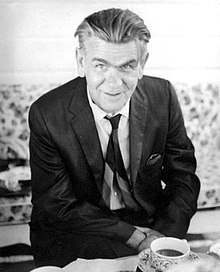Paul Mattick
Paul Mattick | |
|---|---|
 | |
| Born | March 13, 1904 |
| Died | February 7, 1981 (aged 76) |
| Occupation | Council communist theoretician and social revolutionary |
| Years active | 1918-1980 |
| Known for | Left communist anti-Bolshevism, developing Karl Marx's and Henryk Grossman's theory of capitalism for contemporary economics |
| Partner(s) | Frieda Mattick, Ilse Hamm Mattick |
Paul Mattick Sr. (March 13, 1904 – February 7, 1981) was a German Marxist political writer and social revolutionary, whose thought can be placed within the council communist[1] and left communist traditions.
Throughout his life, Mattick continually criticised Bolshevism,[2] Vladimir Lenin[3] and Leninist organisational methods,[4][5] describing their political legacy as "serving as a mere ideology to justify the rise of modified capitalist (state-capitalist) systems, which were [...] controlled by way of an authoritarian state".[6][7]
Early life
Born in Pomerania in 1904 and raised in Berlin by class-conscious parents, Mattick was already at the age of 14 a member of the Spartacists' Freie Sozialistische Jugend. In 1918, he started to study as a toolmaker at Siemens AG, where he was also elected as the apprentices' delegate on the workers' council of the company during the German Revolution.
Implicated in many actions during the revolution, arrested several times and threatened with death, Mattick radicalized along the left and oppositional trend of the German communists. After the "Heidelberg" split of the Communist Party of Germany (KPD; a successor to the Spartacist League) and the formation for the Communist Workers Party of Germany (KAPD) in the spring of 1920, he entered the KAPD and worked in the youth organization Rote Jugend, writing for its journal. In March 1920 he participated in street fighting against the rightist Kapp Putsch, in which his lifelong friend Reinhold Klingenberg was shot and lost a leg.[8]
1921년, 17세의 나이로, Mattick은 Klockner와 함께 일하기 위해 잠시 쾰른으로 이사했다. 파업, 피란, 그리고 새로운 체포가 고용의 모든 가능성을 파괴할 때까지. 쾰른 지역의 KAPD와 AAU에서 조직위원 겸 선동가로 활동하면서 얀 아펠을 알게 되었다. 그는 또한 오토 뤼엘이 설립한 AAUE에서 일하는 지식인, 작가, 예술가들과도 접촉했다. 여기에는 프란츠 세이워트를 중심으로 결성된 단체인 쾰른 진보주의자들이 포함되었다.[8]
특히 1923년 이후 급진적인 집단투쟁과 혁명적 희망이 계속 쇠퇴하고, 여러 해 동안 실업상태였던 매틱은 1926년 미국으로 이민을 갔으며, KAPD와 독일의 AAUE와의 접촉을 계속 유지했다.
미국에서는,
| 다음에 대한 시리즈 일부 |
| 사회주의 북미합중국, 미국 |
|---|
In the United States, Mattick carried through a more systematic theoretical study, above all of Karl Marx. In addition, the publication of Henryk Grossman's principal work, Das Akkumulations - und Zusammenbruchsgesetz des Kapitalistischen Systems (1929), played a fundamental role for Mattick, as Grossman brought Marx's theory of accumulation, which had been completely forgotten, back to the centre of debate in the workers' movement.
| Part of a series on |
| Left communism |
|---|
 |
To Mattick, Marx's "critique of political economy" became not a purely theoretical matter but rather directly connected to his own revolutionary practice. From this time, Mattick focused on Marx's theory of capitalist development and its inner logic of contradictions inevitably growing to crisis as the foundation of all political thoughts within the workers' movement.
Towards the end of the 1920s, Mattick had moved to Chicago, where he first tried to unite the different German workers' organisations. Taking night classes to improve his English, Mattick fell into the orbit of the Proletarian Party, a cliquish grouping of independent Marxists which had been successively drummed out of the Socialist Party (in 1919) and the Communist Party (in 1920), now going it alone with their own party organization. Mattick participated in their meetings and contributed to their party publications for several years, during which he also sometimes spoke in the nighttime lecture series at the bohemian Dil Pickle Club, an IWW hangout.[9] In 1931, under the sponsorship of a local federation of German-speaking socialist clubs and sports groups, he took over as editor of the defunct German-language Chicagoer Arbeiter-Zeitung, a newspaper steeped in radical tradition and at one time edited by August Spies and Joseph Dietzgen. Mattick put out 10 monthly issues between February and December 1931, writing much of the paper's content himself, but the paper failed to achieve a large enough readership to be self-sustaining, and folded at the end of the year.[10] For a period, he joined the Industrial Workers of the World (known as the IWW or Wobblies), who were the only revolutionary union organization existing in America that, in spite of national or sectoral differences, assembled all workers in One Big Union, so as to prepare the general strike to bring down capitalism. However, the golden age of the Wobblies' militant strikes had already passed by the beginning of the thirties, and only the emerging unemployed movement again gave the IWW a brief regional development. In 1933, Paul Mattick drafted a programme for the IWW trying to give the Wobblies a more solid 'Marxist' foundation based on Grossman's theory, although it did not improve the organization's condition. In 1934, Mattick, some friends from the IWW as well as some expellees from the Leninist Proletarian Party formed the United Workers Party, later to be renamed Group of Council Communists. The group kept close contacts with the remaining small groups of the German/Dutch Left communism in Europe and published the journal International Council Correspondence, which through the 1930s became an Anglo-American parallel to the Rätekorrespondenz of the Dutch GIC(H). Articles and debates from Europe were translated along with economic analysis and critical political comments of current issues in the United States and elsewhere in the world.
자신의 공장 작업과는 별개로, 매틱은 리뷰의 기술 작업 대부분을 조직했을 뿐만 아니라, 그 안에 나타난 기여의 대부분을 저술했다. 정기적인 기부금을 기꺼이 내놓으려는 몇 안 되는 사람들 중에는 1935년 매틱과 접촉한 카를 코르슈가 있었고 1936년 말 미국으로 이민을 갔을 때부터 여러 해 동안 개인적인 친구로 남아 있었다.
1930년대 후반 유럽의회 공산주의가 지하로 들어가 정식으로 '사라짐'을 일으키자, 매틱은 1938년에서 리빙 마르크스주의로, 1942년부터는 뉴 에세이(New Essays)로 통신의 이름을 바꾸었다.
칼 코르쉬와 헨리크 그로스만처럼 매틱은 막스 호크하이머의 털 소지알포르스충(후기 프랑크푸르트 학교)과 어느 정도 접촉했다. 1936년 Mattick은 연구소의 파일에 남아 있기는 했지만 SDS 출판사 Neue Kritik에 의해 1969년에야 출판될 이 연구소를 위한 미국 실업자 운동에 대한 주요한 사회학적 연구를 썼다.
제2차 세계 대전 이후
| 다음에 대한 시리즈 일부 |
| 자유사회주의 |
|---|
 |
미국이 제2차 세계대전에 참전하고 전후 매카시즘을 겪은 후, 미국의 좌파는 탄압을 경험했다. 매틱은 1950년대 초반에 시골로 은퇴했는데, 버몬트주 윈홀 근처에 있는 스콧 니잉에 몰려 있는 촌스러운 "땅으로 돌아가는" 식민지의 일부로, 그곳에서 이따금씩의 직업과 작가로서의 활동을 통해 간신히 살아남았다. 전후의 전개에 있어서 매틱은 때때로 여러 가지 정기간행물들을 위한 작은 기사들을 쓰면서, 작고 때때로 정치 활동에만 참여하였다. 마틱은 40년대부터 50년대까지 존 메이너드 케인즈의 연구를 거쳐 케인즈 이론과 실전에 반대하는 일련의 비판적인 메모와 기사들을 정리했다. 그는 이 작품에서 마르크스와 그로스만의 자본주의 발전 이론을 더욱 발전시켜 현대 자본주의의 새로운 현상과 외모를 비판적으로 충족시켰다.
60년대 정치계의 전반적인 변화와 보다 급진적인 사상의 재등장으로 폴 매틱은 좀 더 정교하고 중요한 정치적 공헌을 했다. 주요 작품 중 하나는 마르크스와 케인즈였다. 1969년부터 혼합경제의 한계, 여러 언어로 번역되어 1968년 이후의 학생운동에 상당한 영향을 끼쳤다. 또 다른 중요한 작품은 허버트 마큐스의 비평이다. 마르크스가 이해한 프롤레타리아트가 선진 자본주의 사회에서 신화적 개념이 되었다는 마큐스의 주장을 마틱이 억지로 거부했던 계급사회의 일차원적 인간. 지배 이데올로기에 대한 마르쿠제의 비판적 분석에는 동의했지만, 매틱은 일차원성 이론 자체가 이념으로만 존재한다는 것을 증명했다. Marcuse는 그 후 Mattick의 책이 그의 책에 대한 최고의 비평이었다고 단언했다.[11]
만년
70년대까지, Mattick의 많은 오래된 기사들과 새로운 기사들은 다양한 출판물들을 위해 다른 언어로 출판되었다. 1974-75년 학기에, Mattick은 덴마크의 Roskilde의 "Red" University-Center"에서 초빙교수로 재직했다. 이곳에서 마르크스의 정치경제 비판, 노동자운동의 역사에 대한 강연을 했으며 막시밀리언 루벨, 어니스트 맨델, 조안 로빈슨 등 다른 초청인들과의 세미나에서 비판적 동반자 역할을 했다. 1977년 그는 멕시코시티 대학의 마지막 중요한 강연 투어를 마쳤다. 그는 서독에서 1971년 베를린에서 1975년 하노버에서 두 번 연설했다.
그의 말년에, Mattick은 그의 견해에 대해 새로운 세대 내에 소수의 청중을 얻는 데 성공했다. 1978년, 40년 이상 된 주요 기사 모음은 반 볼셰비키 공산주의로 나타났다.
Mattick은 1981년 2월에 다른 책을 위해 거의 완성된 원고를 남기고 세상을 떠났고, 이후 그의 아들 Paul Mattick Jr.에 의해 마르크스주의로 편집되고 출판되었다 - 부르주아주의 최후의 피난처?
참조
- ^ "Council Communism - Paul Mattick".
- ^ "Anti-Bolshevist Communism in Germany - Paul Mattick".
- ^ "The Lenin legend - Paul Mattick".
- ^ "The Masses & The Vanguard - Paul Mattick".
- ^ "Luxemburg versus Lenin - Paul Mattick".
- ^ Mattick, Paul (2007) [1978]. Anti-Bolshevik Communism. Wales: The Merlin Press. pp. Introduction, XI. ISBN 978-0-85036-223-7.
- ^ Mattick, Paul. "Introduction to Anti-Bolshevik Communism by Paul Mattick".
- ^ a b 로스, 게리. A Lost Century의 마르크스주의: 폴 매틱의 전기, (Brill, 2014), 페이지 27.
- ^ 로스, 게리. 잃어버린 세기의 마르크스주의, (Brill, 2014), 페이지 134.
- ^ 로스, 게리. 잃어버린 세기의 마르크스주의.
- ^ Aronowitz, Stanley (2001). The Last Good Job in America: Work and Education in the New Global Technoculture. Lanham, Maryland: Rowman and Littlefield. pp. 258. ISBN 978-0742509757.
외부 링크
- Paul Mattick 아카이브(libcom.org)
- 쿠라스제 - 평의회 공산당 기록 보관소 - 이 본문의 원본
- 폴 매틱 인터넷 아카이브
- 폴 매틱 홈페이지
- 독일 폴 매틱 아카이브(MIA)
- 국제 위원회 통신, 1934-43 내용
주요 작업
- 미사와 뱅가드
- 공의회
- 반 볼셰비키 공산주의에 대한 소개
- 자본주의와 생태학: 자본의 쇠퇴에서 세계의 쇠퇴에 이르기까지
- 마르크스와 케인스: 보스턴, 혼합경제의 한계: 포터 사젠트, 1969
- 뉴욕, 독일의 반 볼셰비스트 공산주의: 텔로스 프레스, 26, 1975-76년 겨울
- 볼셰비키 반공산주의, 웨일즈: 멀린 프레스, 1978년 (2007년 개정) ISBN 978-0-85036-223-7
- 경제위기와 위기이론, 런던: 멀린 프레스, 1981년 (트랜스) 폴 매틱 주니어)

